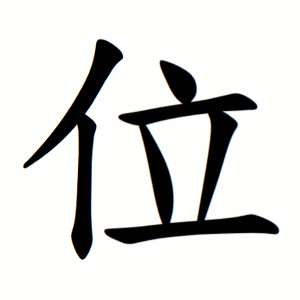位
- status, place, position;
Etymology
A semantic compound:
人 (사람 인) — person.
立 (설 립) — to stand.
Together they depict “the place where a person stands,” hence “position” or “seat.”
Semantic range:
- seat, place, position (자리, 위치, 좌석);
- official rank, status, dignity;
- a polite classifier for people (modern Chinese: 一位先生, “a gentleman”);
- tablet, memorial (esp. in ancestral rites);
- figuratively: numerical place value, digital bit.
Usage in Korean
位置 (위치) — location, position
地位 (지위) — social rank, standing
方位 (방위) — direction, orientation
職位 (직위) — office, post
司祭位 (사제위) — priesthood office
Words that derived from 位
- 단위(單位)–unit
- 방위(方位)–bearing; point of the compass
- 본위(本位)–principle
- 사위기대(四位基臺)–four position foundation
- 삼위일체(三位一體)–trinity; the Trinity
- 왕위(王位)–throne; kingship
- 우위(優位)–superiority; dominant position; ascendancy
- 위(位)–A unit used to indicate a rank or order
- 위치(位置)–location; situation; position; place
- 재위(在位)–being on the throne
- 지위(地位)–status; rank; position; significance
- 체위(體位)–posture
Additional notes
In Confucian ritual culture, 位 carries the sense of assigned place within the cosmic and social hierarchy. To know one’s 位 (“place”) and act accordingly was considered a core virtue in maintaining li (禮, propriety).
In ancestral rites, 位 refers to the spiritual “seat” (위패, spirit tablet) of the deceased, embodying presence and respect.
In Korean Catholic usage, 位 is employed to count saints and martyrs (e.g., “한국 103位 성인” — the 103 Korean Saints). Here 位 functions as a respectful unit of enumeration for holy persons, emphasizing their honored standing before God.
In church liturgy and memorial contexts, 位 may appear in inscriptions for the departed faithful, paralleling its ancestral rite use but reoriented toward Christian remembrance and intercession.
